Bhilawa/Bhallataka (Semecarpus anacardium): Benefits & Uses
In the world of traditional medicine, the Bhilawa/Bhallataka plant, scientifically known as Semecarpus anacardium, has held a revered place for centuries. Its rich chemical composition and various useful parts have made it a cornerstone in Ayurveda, the ancient Indian healing system. This article will delve into the intricate details of Bhilawa/Bhallataka, exploring its composition, qualities according to Ayurveda, influence on doshas, health benefits, medicinal uses, how to use it, and essential safety precautions.
What is Bhilawa/Bhallataka?
Bhilawa/Bhallataka, Semecarpus anacardium, is a valuable medicinal plant in Ayurveda. Belonging to the Anacardiaceae family, this deciduous tree bears small, fleshy drupe fruits. Its bioactive compounds, including cardol and anacardic acids, confer potent anti-inflammatory and antioxidant properties. Used in various Ayurvedic formulations, Bhilawa/Bhallataka addresses inflammatory disorders and aids digestion. While its fruits and seeds are particularly useful for medicinal purposes, it is advisable to exercise caution due to its hot potency.
Classical Categorization of Bhilawa/Bhallataka (Semecarpus anacardium)
According to classical Ayurvedic texts, Bhilawa/Bhallataka holds a significant position due to its potent medicinal properties. Different Acharyas (Ayurvedic scholars) have categorized it under various therapeutic groups:
-
Charaka Samhita:
-
Deepaneeya – Herbs that promote digestion
-
Bhedaniya – Herbs that induce mild purgation
-
Kushtaghna – Herbs beneficial in treating skin disorders
-
Mutrasangrahaneeya – Herbs that help in urine retention
-
-
Sushruta and Vagbhata:
-
Included in Nyagrodhadi Gana and Mustadi Gana, therapeutic groups with varied systemic effects
-
-
Bhavaprakasha Nighantu:
-
Classified under Hareetakyadi Varga, a category known for rejuvenative and detoxifying herbs
-
Habitat of Bhilawa/Bhallataka
Bhilawa/Bhallataka grows commonly in the hotter regions of India, thriving particularly in tropical and subtropical climates. It is found in forested and hilly terrains across the Indian subcontinent.
Varieties of Bhilawa/Bhallataka
As per Sushruta and Nighantu Ratnakara, there are two main varieties of Bhallataka:
-
Bhallataka – The standard medicinal variety
-
Nadi Bhallataka – A variant usually considered less potent or with slightly different therapeutic effects
Morphology of Bhilawa/Bhallataka
Bhilawa/Bhallataka is a medium-sized deciduous tree, which typically grows to a height of 30 to 50 feet. It has distinct morphological characteristics:
-
Bark: Grey in color; when incised, it exudes an irritant resinous secretion that can cause skin reactions
-
Leaves: Simple, obovate-oblong, with an ashy gray appearance
-
Inflorescence: Appears as a compound panicle
-
Flowers: Small, greenish-yellow in color, borne on long stalks
-
Fruits: Drupaceous (stone fruit), heart-shaped; green when raw, turning black upon ripening
-
Fruits are attached to a fleshy, orange-colored receptacle, which is edible
-
-
Seeds: Pendulous, embedded within the nut
These characteristics make the plant easy to identify and its parts selectively useful in Ayurvedic formulations.
Useful Parts of Bhilawa/Bhallataka:
Different parts of the Bhilawa/Bhallataka plant are utilized for their medicinal benefits:
- Fruits: The drupe fruits of Bhilawa/Bhallataka are one of the most potent parts of the plant.
- Seeds: The seeds of Bhilawa/Bhallataka are also used for their medicinal properties. They are often processed to make medicated oils and pastes used in traditional Ayurvedic therapies.
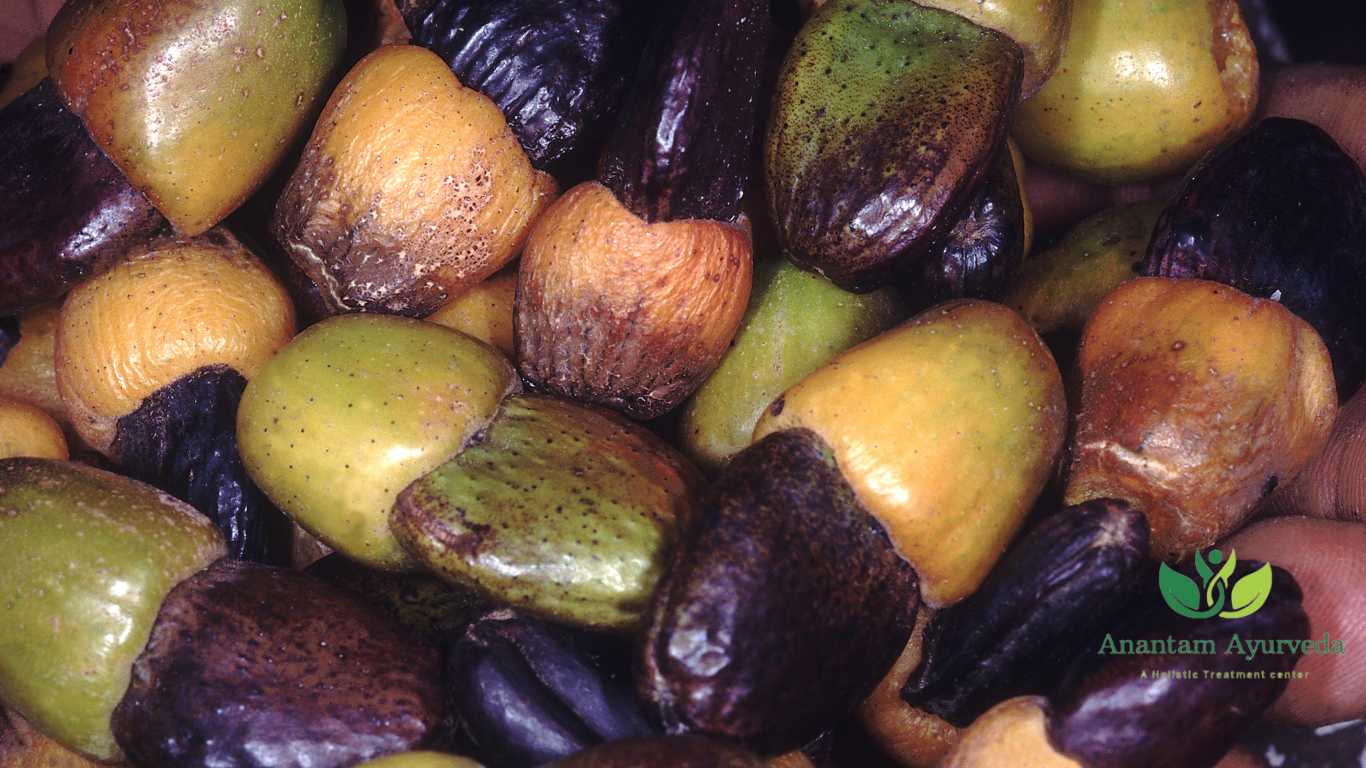
Medicinal Properties of Bhilawa/Bhallataka (Semecarpus anacardium)
Bhilawa/Bhallataka is a highly potent Ayurvedic herb with strong therapeutic value. Its medicinal properties are explained through Ayurvedic principles and supported by modern pharmacological actions.
Ayurvedic Properties
| Parameter | Description |
|---|---|
| Rasa (Taste) | Katu (Pungent), Tikta (Bitter), Kashaya (Astringent) |
| Guna (Qualities) | Laghu (Light to digest), Teekshna (Piercing), Snigdha (Unctuous) |
| Vipaka | Madhura (Sweet post-digestive effect) |
| Veerya (Potency) | Ushna (Hot in potency) |
These attributes contribute to Bhallataka’s effectiveness in stimulating digestion, reducing inflammation, and managing kapha and vata-related disorders.
Pharmacological Actions
Bhilawa/Bhallataka demonstrates a wide range of pharmacological properties:
-
Anti-cancerous – Shows potential in inhibiting tumor growth and supporting cancer therapies
-
Anti-bacterial – Effective against a variety of pathogenic microorganisms
-
Cardiac depressant – Helps lower heart rate and reduces cardiac workload
-
Anti-allergic – Reduces allergic reactions and supports immune modulation
-
Hypotensive – Helps in lowering high blood pressure
-
Anti-arthritic – Relieves joint inflammation and pain in arthritic conditions
-
Anti-inflammatory – Reduces swelling and inflammation in chronic conditions
Dosage (Matra)
| Form | Recommended Dose |
|---|---|
| Taila (Oil) | 10 – 20 drops |
| Kalka | 3 gm |
Note: Dosages must be strictly followed and administered only under qualified Ayurvedic supervision due to the herb’s strong potency.
Fatal Dose
-
5 to 10 grams (pulpy juice) & 140-150 grains of Bhilawa/Bhallataka can be fatal.
Fatal Period
-
Symptoms of toxicity or fatality may appear within 12 to 24 hours after ingestion of a toxic dose.
Side Effects of Overdose
Improper use or overdose of Bhilawa/Bhallataka can lead to severe adverse effects:
-
Formation of blisters on the tongue and throat
-
Excessive thirst and profuse sweating
-
Heartburn and acidity
-
Oliguria (reduced urine output)
-
Swelling in various parts of the body
-
Renal failure in extreme cases
-
Gastrointestinal tract infections
Always consult an experienced Ayurvedic practitioner before using Bhilawa/Bhallataka in any form, to ensure safety and therapeutic efficacy.
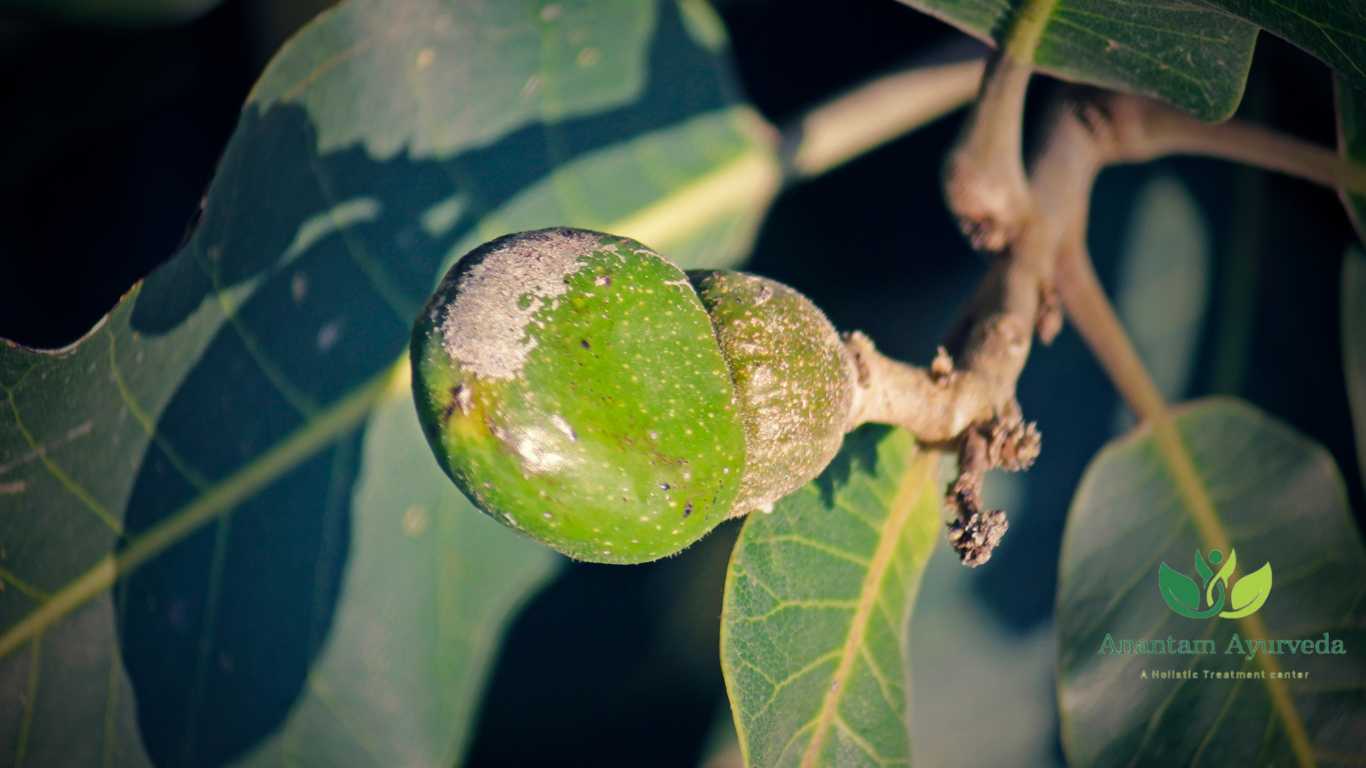
Bhilawa/Bhallataka’s Influence on Doshas in Ayurveda
In Ayurveda, the concept of doshas refers to the fundamental energies or principles that govern the functioning of the human body. These doshas, namely Vata, Pitta, and Kapha, influence various physiological and psychological processes. Bhilawa/Bhallataka, with its unique properties, has a significant impact on these doshas:
1. Vata Dosha: Bhilawa/Bhallataka’s qualities help pacify Vata dosha imbalances. Its heating potency (ushna virya) counterbalance the cold nature of Vata, making it beneficial for conditions related to the nervous system and joints.
2. Kapha Dosha: Bhilawa/Bhallataka’s lightness (laghu) quality make it useful in balancing Kapha dosha, which is characterized by heaviness and excess moisture. These qualities help in reducing mucus and congestion in the body.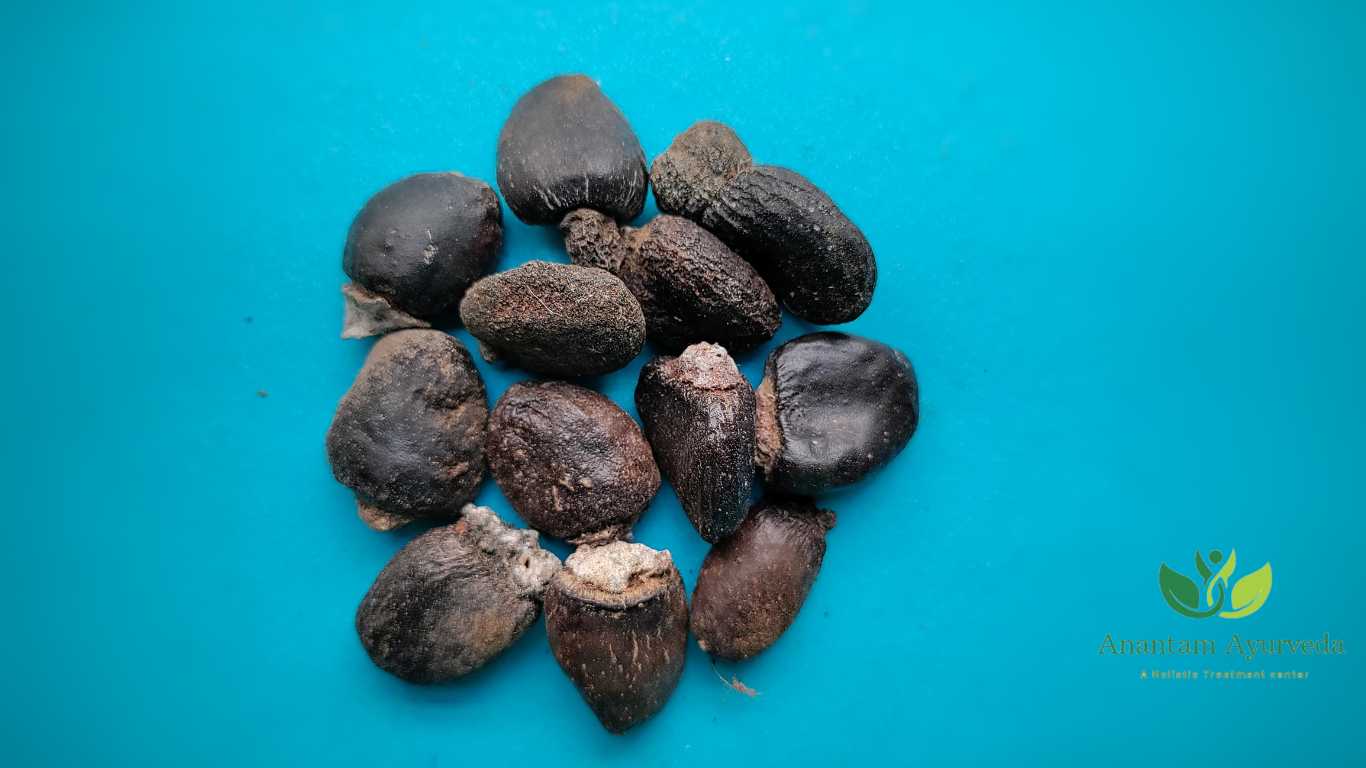
Health Benefits of Bhilawa/Bhallataka (Semecarpus anacardium)
Its diverse properties make it a valuable herb for various health conditions. Here are some of its notable health benefits:
1. Anti-inflammatory Properties: Bhilawa/Bhallataka is renowned for its potent anti-inflammatory effects. It helps in reducing inflammation in the body, making it beneficial for conditions like arthritis, skin disorders, and inflammatory joint diseases.
2. Digestive Aid: This herb aids digestion by stimulating the digestive fire (agni), promoting efficient digestion and assimilation of nutrients. It is particularly helpful for individuals with weak digestion or sluggish metabolism.
3. Respiratory Support: Bhilawa/Bhallataka acts as a bronchodilator, making it effective in respiratory conditions such as asthma and bronchitis. It helps in clearing the respiratory passages and promotes easy breathing.
4. Immune Booster: Rich in antioxidants, Bhilawa/Bhallataka strengthens the immune system, making the body more resilient against infections and diseases. Regular consumption can enhance overall immunity.
5. Neurological Health: In Ayurveda, Bhilawa/Bhallataka is used to support neurological health. It have rejuvenating effects on the nervous system, improving nerve function and mental clarity.
6. Skin Care: The herb is beneficial for various skin disorders due to its anti-inflammatory and detoxifying properties.You can use it both internally and externally to promote clear and healthy skin.
7. Antimicrobial Properties: Bhilawa/Bhallataka exhibits antimicrobial properties, making it effective against certain bacteria and fungi. You can use it to prevent and treat infections in the body.
8. Stress Management: Ayurvedic practitioners use Bhilawa/Bhallataka to manage stress and anxiety. Its calming effects on the nervous system can help in reducing stress levels and promoting relaxation.
9. Anticancer Properties: Research indicates that Bhilawa/Bhallataka may possess compounds with potential anticancer properties. Studies are ongoing to explore its role in cancer prevention and treatment.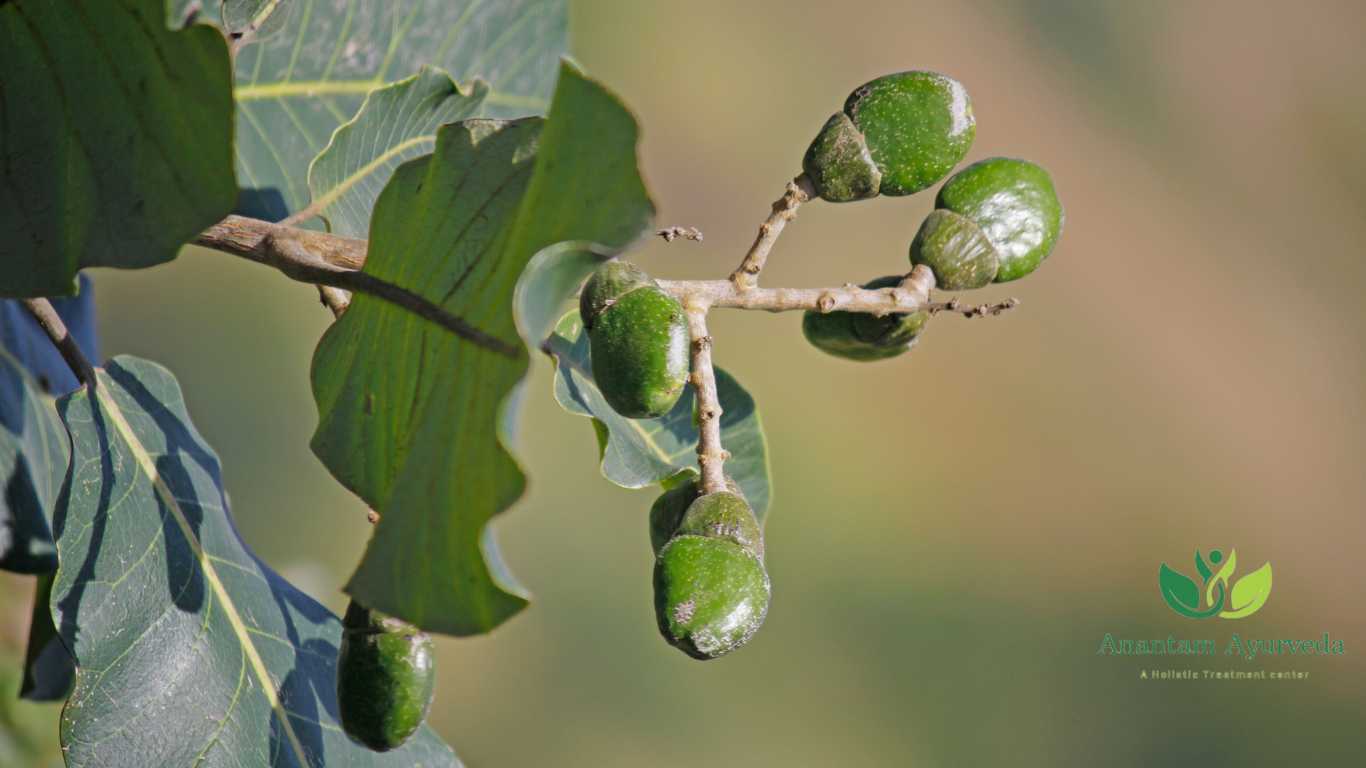
How to Purify Bhilawa/Bhallataka (Semecarpus anacardium) in Ayurveda
Bhallataka, also known as Semecarpus anacardium or Marking Nut, contains potent bioactive compounds. However, in its raw form, it can irritate the skin and mucous membranes, causing allergic reactions, blisters, or gastrointestinal issues. To make it safe for therapeutic use, Ayurvedic experts always perform Shodhana (purification) before administration.
1. Select Only Healthy Nuts
Practitioners carefully select mature, unbroken Bhallataka nuts. They discard any nuts showing signs of damage, fungal infection, or cracks to ensure only potent and uncontaminated fruits undergo purification.
2. Soak in Cow’s Urine or Milk
Vaidyas soak the selected nuts in cow’s urine (Gomutra) for 7 consecutive days, stirring them daily. Alternatively, they may use cow’s milk, replacing it every 24 hours for 3 days. This step neutralizes toxic resin compounds and boosts the herb’s potency.
3. Boil in Cow’s Milk or Water
After soaking, they boil the nuts in cow’s milk or water for 3–4 hours using the Dolayantra method (Ayurvedic double boiler). This process removes irritants like Bhilawanol and reduces the risk of skin burns or inflammation.
4. Remove the Outer Resinous Layer
Once boiled, they rub the softened nuts with brick powder, sand, or a rough cloth to gently strip off the toxic black resin layer. This resin contains most of the allergenic substances.
5. Sun Dry Thoroughly
Ayurvedic practitioners then spread the nuts under direct sunlight to dry completely. Sun-drying ensures that moisture is eliminated, preventing fungal growth and preserving medicinal strength.
6. Store in Airtight Containers
Finally, they store the purified Bhallataka in airtight jars placed in a dry, cool space. This ensures the herb remains fresh, safe, and potent for medicinal use.
Why Do We Purify Bhilawa/Bhallataka?
-
Detoxifies the Herb: The Shodhana process removes harmful compounds that cause skin rashes and digestive distress.
-
Improves Therapeutic Efficiency: Purification enhances Bhallataka’s healing properties by refining its potency.
-
Minimizes Side Effects: Proper purification prevents blisters, allergic reactions, or organ damage due to toxicity.
Use of Purified Bhilawa/Bhallataka in Ayurveda
After undergoing Shodhana, Bhallataka becomes a valuable ingredient in formulations like:
-
Bhallataka Rasayana
-
Agni Tundi Vati
-
Kaishore Guggulu
These classical medicines help manage skin disorders, digestive complaints, inflammatory conditions, and immune imbalances.
Conclusion: Ayurveda emphasizes the safe and therapeutic use of herbs like Bhallataka. Proper purification not only detoxifies the herb but also unlocks its full healing potential. Always use Bhallataka under the supervision of a qualified Ayurvedic practitioner to enjoy its benefits without risk.
How to Use Bhilawa/Bhallataka (Semecarpus anacardium)
Bhilawa/Bhallataka, scientifically known as Semecarpus anacardium, is a potent herb in Ayurveda, known for its various health benefits.
1. Internal Use:
- Powder: Bhilawa/Bhallataka is often ground into a fine powder. The recommended dosage of the powder varies depending on individual constitution and the purpose of use. Generally, a dose of 125-250 milligrams is advised.
- Decoction: You can prepare a decoction of the herb by boiling it in water. This decoction serves as a digestive aid and is typically consumable in small quantities (20-30 ml) after meals to alleviate digestive disorders.
- Medicated Ghee: Ayurvedic practitioners typically recommend processing Bhilawa/Bhallataka with ghee (clarified butter) in small quantities for specific therapeutic purposes. You can utilize this form based on the guidance provided by an Ayurvedic expert.
2. External Use:
- Medicated Oil: You can apply Bhilawa/Bhallataka oil externally, particularly for massages targeting arthritis and joint pain. Simply apply the oil gently to the affected area and massage it in for relief.

Bhilawa/Bhallataka Fruit (After Ripening)
The ripened fruit of Bhallataka exhibits a range of medicinal qualities, making it a potent herb in Ayurvedic practice. Here’s a breakdown of its key properties and health benefits:
| Ayurvedic Property | Explanation |
|---|---|
| Rasa (Taste) | Sweet in post-digestive effect (Svadupaka), Astringent (Kashaya) |
| Guna (Quality) | Light to digest (Laghu), Unctuous (Snigdha), Piercing (Teekshna) |
| Virya (Potency) | Hot (Ushna) |
| Action (Karma) | Digestive (Pachana), Cutting (Chedana), Purgative (Bhedi) |
| Medhya | Enhances intelligence and cognition |
| Vahnikara | Stimulates digestive fire |
| Kaphavatahara | Balances Kapha and Vata doshas |
| Vranahara | Promotes wound healing |
| Udarahara | Helpful in ascites (fluid accumulation in abdomen) |
| Kushtaghna | Beneficial in skin diseases |
| Arshahara | Useful in treating piles |
| Grahani | Improves digestion and absorption in malabsorption syndrome |
| Gulma | Relieves abdominal bloating and gaseous distension |
| Shophahara | Reduces inflammation |
| Anaha | Relieves bloating and abdominal fullness |
| Jwaraghna | Helpful in reducing fever |
| Krimighna | Destroys intestinal parasites and worms |
Bhallataka Seed Kernel
The seed kernel of Bhallataka, when properly purified, also holds medicinal significance:
-
Taste & Nature: Sweet and aphrodisiac
-
Bruhmani: Nourishes the body and supports tissue building
-
Balances Doshas: Especially effective in balancing Vata and Pitta doshas
Bhilawa/Bhallataka Bark
-
Hair Care: Promotes healthy hair and scalp
-
Digestive Aid: Enhances digestion and improves appetite
⚠️ Important Note: Bhallataka should always be used under the guidance of a qualified Ayurvedic practitioner, as improper use can cause adverse reactions due to its potent and sometimes irritant properties.
Collection of Bhilawa/Bhallataka (Marking Nut) Fruits
Reference: Charaka Samhita, Chikitsa Sthana 1.2/13
Ideal Characteristics of Fruits for Collection:
Bhallataka fruits selected for medicinal use should be:
-
Undamaged and free from physical defects
-
Full of rasa (taste and therapeutic essence)
-
Fully matured in potency (veerya)
-
Proper in size and appearance
-
Ripe and ready, resembling Jamun (Jambu) fruits in quality
Right Time for Collection:
-
Months:
-
Suchi (Jyeshtha) – May to June
-
Shukra (Ashadha) – June to July
-
-
These months ensure the fruits are naturally ripe and potent for use in Ayurvedic formulations.
Storage Method:
-
After collection, the fruits should be stored for 4 months to maintain their potency.
-
Storage Media:
-
Inside a heap of Yava (Barley – Hordeum vulgare)
-
Or Masha (Black gram)
-
This traditional storage method helps preserve the medicinal strength and prevent degradation from moisture or pests.
Method of Administration of Bhallatak Rasayana
Ideal Time for Administration
-
Season: The ideal time is during the months of Margashirsha (Agrahayana) and Pushya (Sahasya) — which correspond to November to January.
-
This timing is recommended to balance Bhallataka’s ushna virya (heating potency), as the cold weather naturally helps offset its intense heat.
Pre-administration Preparations
-
Prior to administering Bhallatak Rasayana, the body should be prepared by:
-
Smearing it with cooling, unctuous, and sweet herbal oils or pastes.
-
This reduces the risk of burning sensation caused by the heating and sharp nature of Bhallataka.
-
How to Prepare Bhilawa/Bhallataka Decoction
-
Start with 10 ripe Bhallataka fruits.
-
Boil the fruits in 8 parts of water.
-
Reduce to 1/8th by boiling.
-
Filter the decoction.
-
Mix with milk before administration.
-
Apply ghee to the patient’s mouth before giving the preparation.
Dosage Schedule
-
Begin with 10 fruits on Day 1.
-
Increase by 1 fruit per day until the count reaches 30 fruits.
-
Then decrease by 1 fruit per day back to 10 fruits.
-
This cycle can be repeated until a total of 1,000 fruits have been administered.
Note: Never exceed 30 fruits/day, as this is considered the maximum safe dosage.
Pathya (Recommended Diet During Rasayana Therapy)
-
After digestion, the patient should consume:
-
Shali or Shashtika rice with milk and ghee.
-
-
Eventually, the diet should be restricted to milk alone, twice daily, to:
-
Act as a coolant,
-
Balance Bhallataka’s heating effect, and
-
Enhance the rasayana (rejuvenative) benefits.
-
Benefits of Bhallatak Rasayana
-
Promotes longevity — helps live up to 100 years.
-
Enhances immunity, digestion, and mental clarity.
-
Revitalizes the entire system, restoring strength and vitality.
ChatGPT said:
Ayurvedic Formulations Containing Bhallataka
| Formulation Name | Primary Uses |
|---|---|
| Bhallataka Rasayana | Rejuvenator; enhances immunity, treats chronic diseases like skin disorders and piles |
| Agni Tundi Vati | Improves digestion, treats bloating, colic, and loss of appetite |
| Kaishore Guggulu | Beneficial in skin disorders, blood purification, and arthritis |
| Agnimanthadi Kashaya | Used in managing inflammation and joint disorders |
| Bhallatakadi Taila | External application for arthritis and joint pain relief |
| Panchatikta Ghrita Guggulu | Treats chronic skin diseases, boils, and inflammatory conditions |
| Chitrakadi Vati | Enhances digestive fire (Agni), useful in indigestion and constipation |
| Amritadi Guggulu | Used in arthritis, gout, and joint disorders |
| Bhallatak Avaleha | Used as a general tonic, improves strength and immunity |
| Bhallatak Vati | Used in digestive issues, piles, and skin disorders |
🔶 Note: These formulations should always be taken under the supervision of a qualified Ayurvedic practitioner, as Bhallataka is a potent herb and requires proper processing and dosage control.
Safety and Precautions
-
You must use Bhilawa/Bhallataka under the guidance of an experienced Ayurvedic practitioner, given its potent nature.
-
Pregnant and lactating women, as well as individuals with sensitive constitutions, must avoid using it.
-
An Ayurvedic expert should determine precise dosages and methods of administration to prevent adverse effects resulting from overuse or incorrect usage.
- Individuals with pre-existing medical conditions or those taking other medications should consult a healthcare professional before using Bhilawa/Bhallataka.
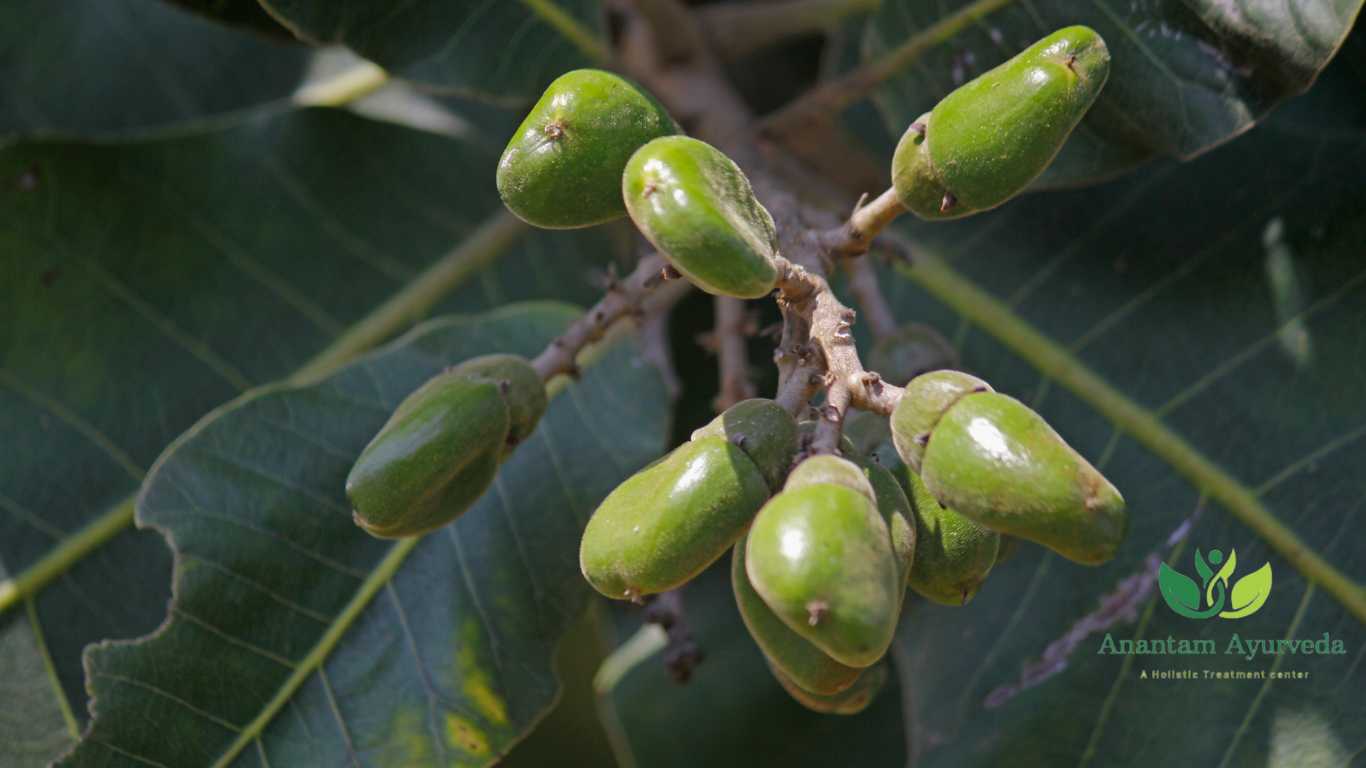
Careful monitoring of Bhilawa/Bhallataka’s usage is crucial to maximize benefits while minimizing potential risks, considering its powerful effects on the body. Ayurveda emphasizes individualized treatment, and what works for one person may not be suitable for another, highlighting the importance of personalized guidance from an Ayurvedic practitioner.
In conclusion, Bhilawa/Bhallataka, with its rich chemical composition and diverse medicinal properties, stands as a testament to nature’s healing capabilities. When used wisely and under expert guidance, it can usher in a new era of holistic well-being, aligning our bodies with the natural rhythms of life.
Frequently Asked Questions (FAQs) about Bhallataka
-
What is Bhallataka?
-
Bhallataka (Semecarpus anacardium), commonly known as the Marking Nut, is a powerful herb used in Ayurveda for treating various ailments, including skin diseases, digestive disorders, and respiratory conditions.
-
-
What are the health benefits of Bhallataka?
-
Bhallataka provides numerous health benefits, such as:
-
Enhancing digestive fire and metabolism.
-
Alleviating skin conditions like eczema and psoriasis.
-
Acting as an immune booster and rejuvenator (Rasayana).
-
Managing respiratory issues like asthma.
-
Supporting joint health and relieving arthritis symptoms.
-
-
-
How is Bhallataka used in Ayurvedic formulations?
-
Bhallataka is an essential ingredient in various Ayurvedic medicines, including:
-
Bhallataka Rasayana – A rejuvenative tonic for overall vitality.
-
Agni Tundi Vati – Helps improve digestion and appetite.
-
Kaishore Guggulu – Beneficial in treating skin disorders and arthritis.
-
Chitrakadi Vati – Used to stimulate digestive fire and aid in metabolism.
-
Arshoghni Vati – Effective in managing piles and hemorrhoids.
-
-
-
What is the recommended dosage of Bhallataka?
-
The dosage of Bhallataka depends on the form and the individual’s health condition. It is generally administered in purified form under strict supervision. Always consult an Ayurvedic practitioner before use.
-
-
Are there any side effects of Bhallataka?
-
Yes, improper use of Bhallataka can lead to adverse effects, such as:
-
Skin irritation and blisters.
-
Gastrointestinal discomfort, nausea, and vomiting.
-
Increased body heat and excessive sweating.
-
Allergic reactions in sensitive individuals.
-
-
Purification (Shodhana) is necessary to minimize these risks.
-
-
Can Bhallataka be used during pregnancy?
-
No, Bhallataka is strictly contraindicated during pregnancy and lactation due to its potent and potentially harmful effects.
-
-
Is Bhallataka safe for everyone?
-
Bhallataka should be used with caution and only under medical supervision. It is not recommended for children, pregnant or lactating women, or individuals with hypersensitivity to the herb.
-
-
How is Bhallataka purified for medicinal use?
-
The purification (Shodhana) process includes soaking the nuts in cow’s urine or milk, boiling in water or milk, rubbing off the toxic outer layer, and drying them before use. This reduces its toxic effects and enhances its medicinal properties.
-
Disclaimer: This information is for educational purposes only. Always consult an Ayurvedic expert before using Bhallataka for medicinal purposes.
You can also read about Sarpagandha (Rauvolfia serpentina): Is It Good for Hypertension?
